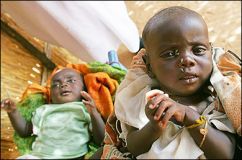Report catalogs high death rate in Darfur
CHICAGO, March 22 (Reuters) – Violence, starvation and disease are killing people in the war-torn Darfur region of Sudan at a pace four to six times greater than the usual mortality rate in sub-Saharan Africa, a report said on Tuesday.

|
|
A twin Sudanese brother and sister wait to be attended by medical staff in September 2004 in an internally displaced persons camp.. |
The finding, based on studies made at three sites in South Darfur, reinforce “the need to mount appropriate and timely humanitarian responses,” said the report from doctors in Amsterdam working for Medecins Sans Frontieres (Doctors Without Borders).
The report, published in this week’s Journal of the American Medical Association, cataloged conditions in parts of the region where tens of thousands have been killed since a rebellion erupted in 2003 due to tribal conflicts over scarce resources.
Thousands are dying every month in squalid camps which house almost 2 million people who have fled their homes in the vast, arid region.
The humanitarian group’s members said they surveyed 137,000 displaced people in August and September 2004 at three sites where the group had been providing food and medical care — Kass, Kalma, and Muhajiria.
“The crude mortality rates at all three sites were considerably higher than the one per 10,000 per day that is recognized internationally as defining an emergency situation and four to six times the expected rate in sub-Saharan populations,” the report said.
“Deaths from medical causes predominated in Kass and Kalma with diarrheal diseases responsible for many of those deaths affecting mainly young children under five and adults older than 50,” it added.
At Muhajiria violence was the major cause of death in 72 percent of all cases, with all but one of the violent deaths in men, the report said.
Malnutrition runs high, particularly in Kalma where nearly 24 percent of children younger than 5 suffered from it, the doctors said.
Even among those who had access to food and nonfood items, many still did not have safe water and sanitation, the report said.
“Additional efforts from humanitarian and governmental actors are urgently needed to guarantee acceptable living standards for these populations,” the authors concluded.
– Full text of the report is available at http://jama.ama-assn.org/cgi/content/full/293/12/1453
